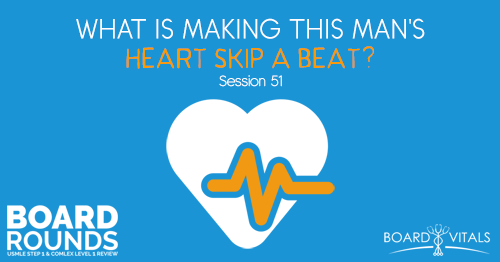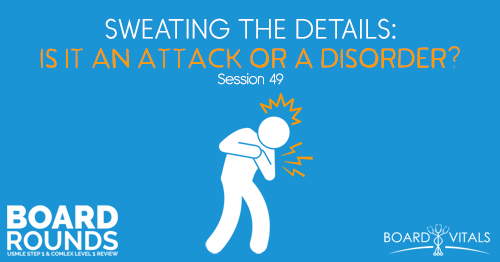Apple Podcasts | Google Podcasts

Session 48
A 20-y/o student presents with anxiety, but her other symptoms suggest her diagnosis may not be so straight-forward. If it isn’t GAD, what could it be?
As always, I’m joined by Dr. Mike Natter from BoardVitals. If you are looking for some more help with your board prep, check out everything they have to offer.
Also, be sure to listen to the Special Stories podcast to help you figure out what specialty you will want to practice in the future. For more podcasts and resources, go over to Meded Media.
Follow us on Instagram at @mike.natter and @medicalschoolhq.
[01:06] BoardVitals
Their massive queue bank database will help you prepare for Step 1 or Level 1 and even in the future as well for your Shelf exams. Check out everything they have to offer. For medical students, whether you’re in an allopathic school or an osteopathic school BoardVitals has you covered. Again, use the promo code BOARDROUNDS to save 15% off.
[01:56] Question of the Week
A 20-year-old student presents to the emergency department with palpitations, insomnia, and anxiety for two months. She reports feeling irritable and experiencing severe mood swings that are interfering with her sleep and relationships.
She emits crying spells and frequent fights with their friends and family. She’s lost 12 pounds in the past two months and has no apparent alteration in her diet or physical activity. Although she is happy with her weight loss.
She denies any past medical or psychiatric problems, but her friends have always been worried that she eats too little. She drinks two to three two to three beers each weekend and denies any tobacco or illicit drugs. The patient’s temperature is 99.5 degrees Fahrenheit. Blood pressure is one 48 over 62. Pulse is 122 and it’s regular. Her respiratory rate is 28 per minute. The exam is significant for a fine tremor of the hands, warm, moist skin. Her eyes and eyelids do not move together during a finger following tests with a steady head.
Which of the following is the most likely cause of her symptoms?
(A) generalized anxiety disorder
(B) anxiety due to a medical condition
(C) somatic symptom disorder
(D) conversion disorder
[03:36] Thought Process Behind the Correct Answers
There’s no psychiatric history or medical issue in the past. Her weight loss is interesting with no change in diet and physical activities. It’s very easy looking at these answers here to go straight to a potentially where it’s like an anxiety disorder.
But there are all these other clinical issues as well. The temperature’s a little bit elevated. The blood pressure’s a little bit high and the pulse is high. This physical exam with the tremor. So there’s more than just a potential general anxiety disorder.
The answer here is B. The medical condition part tells me she has some sort of a thyroid issue or some sort of hormonal issue where her system is just out of whack with her, her pulse high or blood pressure high, and she’s losing weight. And so obviously when you’re in that kind of state, you’re going to have some sleeping difficulties and sleeping difficulty is going to contribute to anxiety.
These are symptoms that are screaming that we have to screen this young woman for a hyperthyroid and potentially a Graves’ disease.
“The endocrine system has some of the most interesting physical exam findings.”Click To Tweet[07:01] What’s the Possible Disease?
The young woman is seemingly anxious, but her heart rate is super fast. They said it was a regular heart rate, but it’s not uncommon to see atrial fibrillation, which would be irregular with folks that have hyperthyroidism. She’s sweaty, she’s losing weight when she’s not trying to, and she’s young.
We don’t think it’s cancer. All of these things as well as the tremor and lid lag are really pointing toward a hyperthyroid picture. So it’s definitely something that I would call a medical condition and not behavioral or mental health related.
They also are steering you away from the fact that she does not have any mental health history at all. If these physical exam findings weren’t as obvious, you do typically see folks present with things like bipolar and psychosis when they are kind of in their 20s.
So it’s not uncommon to see that. The fact that she’s in that age range initially and you have a feeling that you’re in this behavioral health section, you may kind of go that route.
But always keep in mind that even if you think it’s especially clinical, even if you think it’s mental health related, you still always want to rule out organic, clinical medical causes.
This woman is definitely experiencing symptoms of hyperthyroid. We can also go to the next step and ask what tests we might want to order. Specifically for hyperthyroidism, obviously you want a TSH to see what’s going on. That will give us the answer relatively quickly if she has a very low or undetectable TSH. Remember that hyperthyroid gives you a low or undetectable TSH. And the woman has a very high or elevated T3 being the active form of the thyroid hormone.
If her blood pressure is a little bit elevated, her blood pressure is elevated all the time. She was sweaty, she was having these outbursts.
This is much more rare, but you can consider something like a pheochromocytoma.
We can even break that down. Pheo actually means ugly. And then the chromaffin cells of the adrenal medulla. And the -oma means a mass or a tumor. So you have a tumor of your adrenal medulla, which usually spits out epinephrine, norepinephrine, and adrenaline. So you’re just spitting out that all the time.
You have the symptoms of running through your system. So you’re gonna attack a cardiac and have hypertension. You’re going to be diaphoretic, you’re going to be anxious. If, let’s say she happens to have some thyroid dysfunction and a few pheochromocytoma and maybe her calcium’s messed up or her pancreas is messed up.
So these are things that you can consider besides hyperthyroidism that might also be causing her symptoms. But this is looking much more like hyperthyroidism.
[10:22] Understanding the Other Answer Choices
Conversion disorders are usually characterized with these neurologic symptoms that can’t be explained away by a medical and neurologic condition. It’s usually in the setting of something going on at home or at work, or there’s something the patient is not kind of cognizant of why or what’s going on. There’s something that’s underlyingly triggering it, but you can’t explain it away from a neurological or medical condition, which obviously in this question, you can.
You never want to kind of stigmatize your patient. And even though you as the clinician, you know their legs are working just fine, but they’re limping. So regardless, they actually truly believe that there’s something wrong with their leg. Similarly, but slightly different is this somatic symptom disorder. And fibromyalgia is starting to fall into these categories where again, this patient believes that there is some issue, but it’s because of their emotional distress that’s causing their impairments. It’s not necessarily in the same setting as a conversion disorder where there’s no clear trigger.
The other one is just generalized anxiety. Generally, there are some specific criteria that you have to meet for anxiety. These symptoms actually have to be present for at least six months in order to carry that diagnosis. She does fit some of the criteria, but because you can explain the other symptoms that are more specific for a medical condition, it’s much more likely that it’s that.
Just out of safety, for you to diagnose someone with generalized anxiety, instead of saying they may have a medical condition, you could do them quite a bit of harm by not treating the underlying condition if you missed it.
So you should always want to rule out those first, especially if there’s like nebulous or gray symptoms that you have to pinpoint.
Links:
Follow us on Instagram at @mike.natter and @medicalschoolhq.
SEARCH SITE
LISTEN FOR FREE











